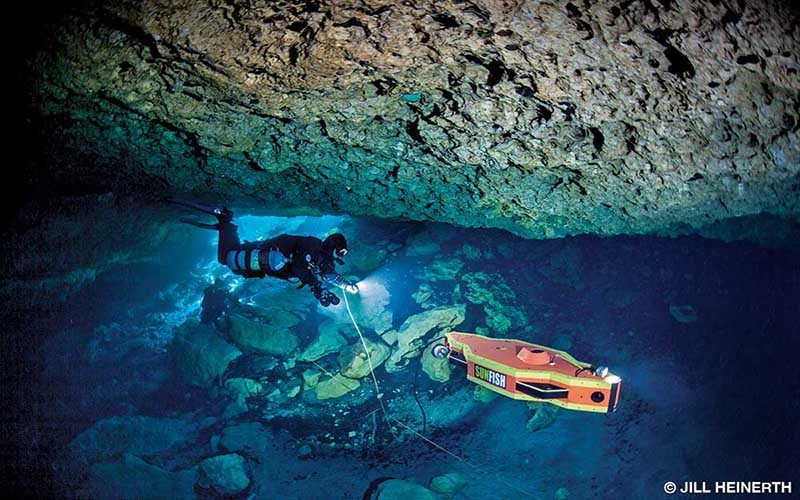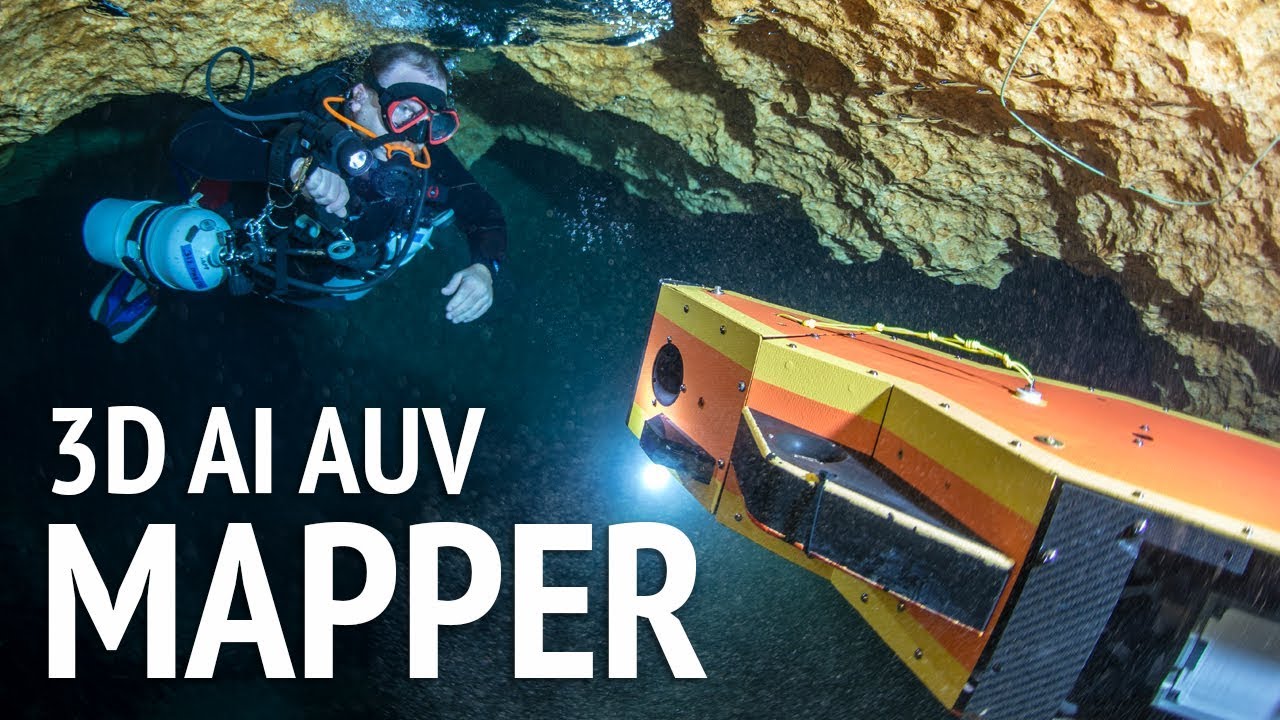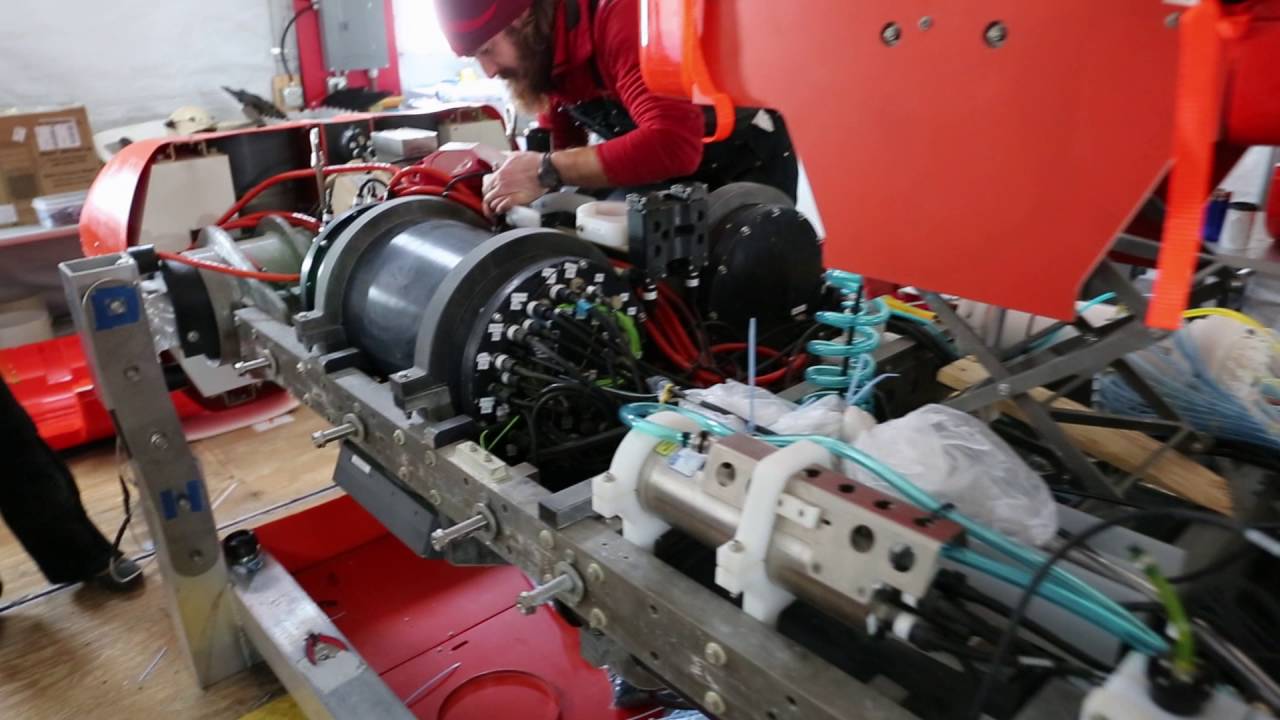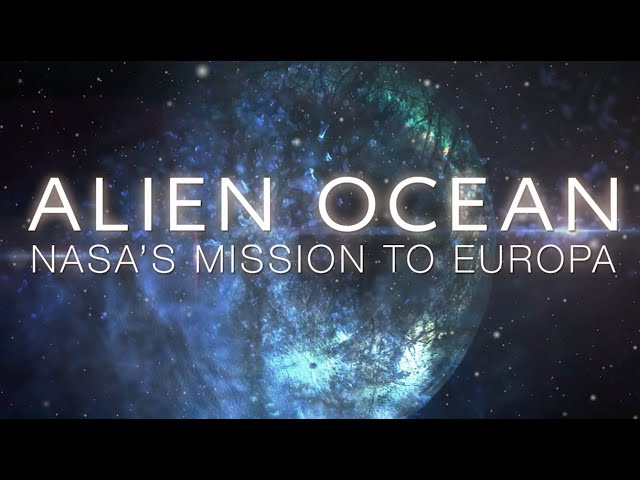On a foggy Sunday morning last October, Bill Stone and his team gently lowered their latest brainchild — an autonomous free-swimming robot named Sunfish — into the water at the P1 entrance of Wes Skiles Peacock Springs State Park in Live Oak, Florida. The goal of their weeklong series of tests: Demonstrate the cello-sized robot’s ability to autonomously explore and create a high-resolution 3-D map of the cave and then safely return to the entrance of its own volition.
The intrepid 65-year-old cave explorer and engineer has spent more than three decades building machines that have enabled him and his cohorts to explore some of the most remote places on Earth. But Sunfish promises to be Stone’s most ambitious development yet: a ticket to explore one of the most remote places in the solar system.
“It’s the next piece of the puzzle in our work to advance NASA’s Europa mission and our first commercial product aside from life support,” explained Stone, founder and CEO of Stone Aerospace, whose lifelong dream has been to advance space exploration and lead a private-sector expedition to the moon.

Sunfish’s release came nearly 30 years to the day after Stone’s paradigm-shattering 1987 Wakulla Springs Expedition, which helped kick-start technical diving. At Wakulla Springs, Florida, Stone and his colleagues — including renowned cave explorer Sheck Exley — introduced the sport-diving world to open-circuit mixed-gas diving, long-range diver propulsion vehicles, decompression habitats and the prototype of his fully redundant Cis-Lunar rebreather.
In 2005, Stone Aerospace licensed its rebreather technology to Poseidon Diving Systems, making it possible for Stone to continue to push the limits of human exploration. In March 2018, Stone and his 60-person U.S. Deep Caving Team headed to Sistema Cheve in southern Mexico, where they hope to reach a depth greater than 6,562 feet (2,000 meters). Their goal, beyond the current furthest point of 4,869 feet (1,484 meters) at Sump Two, lies 6.2 miles (10 kilometers) — a minimum five-day excursion — from the entrance.
The lanky engineer, who NASA once rejected as an astronaut candidate, is clearly a busy guy.
Europa or Bust
Sunfish is the latest in the series of autonomous underwater vehicles (AUVs) that Stone Aerospace has developed in conjunction with NASA’s Astrobiology Science and Technology for Exploring Planets (ASTEP) program, which supports planetary exploration missions. The primary target is the ocean of liquid water that is thought to lie beneath the frozen surface of Jupiter’s moon Europa. Many astrobiologists believe that the storied moon, which is heated from within by Jupiter’s enormous gravitational forces, offers the best chance of finding extraterrestrial life in our solar system.
NASA plans to launch its $2 billion-plus reconnaissance mission to Europa as early as Spring 2022. The spacecraft, dubbed Europa Clipper, will conduct 45 lunar flybys with goals of confirming the existence of a subsurface ocean, searching for evidence of life-supporting chemistry and scouting out potential landing sites. Depending on the results, NASA could then launch a landing mission, despite Arthur C. Clarke’s admonition.
The mission as envisioned will have three components: A nuclear-powered cryobot transport vehicle will land on Europa, tunnel through the 12- to 18-mile-thick surface ice and then release an AUV capable of independently exploring the ocean below. The AUV would contain one or more tethered (or “marsupial”) robots like Sunfish, designed to explore areas of interest such as hydrothermal vents, collect samples and return them to the main AUV.
Send in the Robots
Over the past 15 years, Stone Aerospace has prototyped all the mission components, beginning in 2003 with their first NASA-funded project, the DEep Phreatic THermal eXplorer (DEPTHX), which built upon Stone’s digital mapping technology developed for the Wakulla 2 Expedition in 1998. The autonomous vehicle resembles a giant orange bicycle helmet. It was used to explore and create the first complete map of El Zacatón in southeast Mexico, the world’s deepest water-filled sinkhole at 1,047 feet, where Exley perished in 1994 on an exploration dive to bottom out the cave.
The device also collected water and wall core samples, and in the process discovered four new phyla of bacteria. DEPTHX was later reconfigured with a new science payload and navigation system to create the Environmentally Non-Disturbing Under-ice Robotic ANtarctiC Explorer (ENDURANCE), which spent two seasons mapping and collecting aqueous chemistry data from Lake Bonney, Antarctica, and was featured on National Geographic’s Explorer in 2010.

In 2011 Stone Aerospace began work on the Very deep Autonomous Laser-powered Kilowatt-class Yo-yoing Robotic Ice Explorer (VALKYRIE) cryobot, designed to melt through vast amounts of ice. Four years later Stone led a team to Alaska’s Matanuska Glacier, where they successfully tested a scaled-down version of VALKYRIE. The company’s innovative design, which NASA adopted, conducts a high-energy laser beam over optical fiber to produce hot-water jets that melt the ice ahead of the vehicle.
The same year they launched the 14-foot-long Autonomous Rover/airborne radar Transects of the Environment beneath the McMurdo Ice Shelf (ARTEMIS) submersible, which featured an intelligent algorithm for autonomous scientific sampling and navigation through ice and water. The vehicle, which can travel up to three miles and return to its base, successfully demonstrated a fully autonomous rendezvous and docking recovery beneath Antarctica’s Ross Ice Shelf, a key facet required for the Europa mission.
For the final phase, Stone Aerospace plans to integrate a cryobot with an AUV and test the nestled vehicles in a deep subglacial Antarctic lake. “It’s not science fiction anymore,” Stone said. “If a billionaire wants to put up the money, we could bypass all the baloney and probably launch within five to seven years. We’d be at least 15 years ahead of the planned NASA mission.” The company is currently waiting on a funding proposal from NASA to build the next generation of their self-funded Sunfish.
You Are My Sunfish
Watching Sunfish negotiate Peacock Springs’ water-filled tunnels was a bit like diving into a science-fiction film. Though it requires neither lights nor breathing gas, the 82-pound AUV, which is driven by some 400,000 lines of code, was designed to behave much like a human cave diver. Neutrally buoyant and nonrotating, it can hover motionless with perfect trim in any position.

When given a broad goal such as, “Go a kilometer north,” Sunfish begins by building a 3-D map around itself using acoustic sensors that capture nearly 10,000 data points per second, independent of visibility, in addition to measuring its depth, position and orientation. The AUV processes the data to find the direction that offers the most new volumetric information, then it moves in that direction as far as it can without violating its obstacle-avoidance criteria. An inertial guidance system also measures the vehicle’s velocity to reduce navigation error buildup. Sunfish then repeats the process.
Using these simple behaviors, the AUV can discover dead-end tunnels, back up and try another until it discovers a route forward. In this way, Sunfish gradually constructs what is essentially a virtual dive line that runs through the cave. Once it reaches its goal, Sunfish uses this stored path as a guide to return home, all the while comparing what it sees to the stored features from entry and correcting its trajectory as needed. Using the recorded data, the return is typically a faster process.
After a week of testing and adjusting, Sunfish successfully negotiated the circuitous 450-foot route from P1 to Pothole on its own and returned nearly four times faster than its outbound journey. Stone Aerospace plans to add artificial intelligence (AI) to the robot’s behavioral algorithms, which will improve its navigational abilities.
Stone is convinced that a thinking machine that can explore 3-D environments has a lot of potential applications, from an AUV that could map and monitor remote coral reefs to an ultralight helicopter that could explore Martian lava tubes. But when asked about military applications, he was quick to respond. “I won’t build weapons. I’m not a Tony Stark,” Stone said, referring to the fictitious industrialist who invented Iron Man. “I just want to explore. I don’t have time for other things.”
Explore More
| © Alert Diver — Q2 Spring 2018 |



